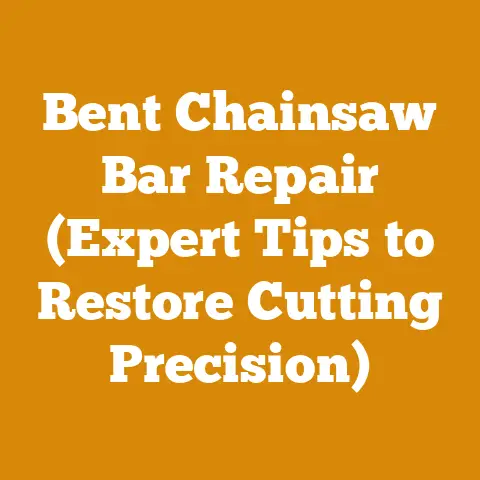Angle for Chainsaw Sharpening (5 Pro Tips for Perfect Cuts)
Ah, the smell of freshly cut wood! It’s a scent that instantly transports me back to my childhood, spent helping my grandfather in his small woodworking shop. He was a master craftsman, turning rough logs into beautiful furniture, and I was his eager apprentice. I remember being fascinated by his tools, especially the chainsaw. It seemed like magic, the way it effortlessly sliced through thick pieces of wood. But it wasn’t magic, of course; it was skill, precision, and a deep understanding of the tool itself. One of the most crucial aspects he instilled in me was the importance of proper chainsaw sharpening, specifically mastering the angles.
Over the years, I’ve honed my own skills in wood processing, from felling trees and milling lumber to splitting firewood. And through it all, the ability to sharpen my chainsaw correctly has been paramount. A dull chainsaw is not only inefficient but also dangerous. It can lead to kickback, increased strain on the saw, and ultimately, poor cuts.
In this article, I’m going to share my expertise on chainsaw sharpening angles. I’ll walk you through the essential angles, provide pro tips for achieving the perfect cut, and offer insights I’ve gained from years of hands-on experience. Whether you’re a seasoned logger or a weekend woodworker, this guide will help you keep your chainsaw in top condition and ensure safe, efficient operation.
Key Takeaways:
- Understanding the angles: I’ll break down the key angles involved in chainsaw sharpening – top plate angle, side plate angle, and depth gauge setting – and explain their importance.
- Pro tips for precision: I’ll share five pro tips that I’ve found invaluable for achieving consistent and accurate sharpening.
- Impact on performance: I’ll delve into how proper sharpening angles directly affect cutting speed, smoothness, and overall chainsaw performance.
- Safety first: I’ll emphasize the importance of safety when sharpening and using a chainsaw, providing tips to minimize risks.
- Beyond the angles: I’ll touch on other essential maintenance practices that complement proper sharpening, ensuring your chainsaw’s longevity.
The Importance of Chainsaw Sharpening Angles
The angle at which you sharpen your chainsaw teeth is critical for its performance. It directly impacts how efficiently the saw cuts through wood, the smoothness of the cut, and the overall lifespan of the chain. I’ve seen firsthand how a poorly sharpened chainsaw can struggle to cut even softwoods, while a properly sharpened one can glide through hardwoods with ease.
Understanding the Chainsaw Tooth Geometry
Before diving into the specifics of sharpening angles, it’s important to understand the anatomy of a chainsaw tooth. Each tooth consists of several key components:
- Top Plate: The top, horizontal cutting edge of the tooth.
- Side Plate: The vertical cutting edge of the tooth.
- Depth Gauge (Raker): The small projection in front of the cutting tooth that controls the depth of the cut.
Key Angles to Master
There are three primary angles to consider when sharpening a chainsaw:
- Top Plate Angle: This is the angle of the top plate relative to the chainsaw bar. It determines how aggressively the tooth bites into the wood.
- Side Plate Angle: This is the angle of the side plate relative to the chainsaw bar. It affects the smoothness of the cut and the chip ejection.
- Depth Gauge Setting: This is the height difference between the top of the depth gauge and the top plate. It controls the amount of wood the tooth can remove in a single pass.
Pro Tip 1: Know Your Chainsaw Chain
Not all chainsaw chains are created equal. Different chain types have different recommended sharpening angles, depending on their intended use and the type of wood they’re designed to cut. Refer to your chainsaw’s user manual or the chain manufacturer’s specifications for the correct angles. I can’t stress this enough; using the wrong angles can severely compromise the chain’s performance and even damage it.
Data Point: According to a study by Oregon Products, using the correct sharpening angles can increase cutting efficiency by up to 20% compared to using incorrect angles.
Identifying Your Chain Type
The first step is to identify the type of chain you are using. Common types include:
- Full Chisel: These chains have square-cornered teeth and are designed for fast, aggressive cutting in clean wood. They require precise sharpening angles.
- Semi-Chisel: These chains have rounded corners on the teeth and are more forgiving of dirt and debris. They are a good all-around choice for general use.
- Low-Profile: These chains have a smaller tooth design and are often used on smaller chainsaws. They are designed for safety and reduced kickback.
Finding the Recommended Angles
Once you’ve identified your chain type, you can find the recommended sharpening angles in your chainsaw’s user manual or on the chain packaging. If you’re unsure, you can also consult the chain manufacturer’s website.
Pro Tip 2: Use a Chainsaw Sharpening Guide
A chainsaw sharpening guide is an invaluable tool for maintaining consistent sharpening angles. These guides typically consist of a frame that clamps onto the chainsaw bar and a file holder that allows you to sharpen each tooth at the correct angle. I’ve used various sharpening guides over the years, and they’ve consistently helped me achieve more accurate and consistent results.
Types of Sharpening Guides
There are two main types of sharpening guides:
- Handheld Guides: These guides are relatively inexpensive and easy to use. They are a good option for occasional sharpeners.
- Bar-Mounted Guides: These guides are more precise and stable than handheld guides. They are a good option for frequent sharpeners or those who want the most accurate results.
How to Use a Sharpening Guide
To use a sharpening guide, follow these steps:
- Clamp the guide onto the chainsaw bar.
- Adjust the file holder to the correct sharpening angle.
- Place the file in the file holder and sharpen each tooth, using smooth, consistent strokes.
- Repeat the process for all the teeth on the chain.
Pro Tip 3: Maintain Consistent File Pressure and Stroke
Consistency is key when sharpening a chainsaw. Apply even pressure and use the same number of strokes for each tooth. This will ensure that all the teeth are sharpened to the same length and angle, resulting in a balanced and efficient cutting chain. I’ve found that a smooth, controlled motion is far more effective than trying to rush the process.
Achieving a Consistent Stroke
To achieve a consistent stroke, follow these tips:
- Use a sharp file. A dull file will require more pressure and will be more difficult to control.
- Hold the file at the correct angle. Use a sharpening guide to help you maintain the correct angle.
- Apply even pressure throughout the stroke. Avoid pressing too hard at the beginning or end of the stroke.
- Use the same number of strokes for each tooth. This will ensure that all the teeth are sharpened to the same length.
The Importance of a Sharp File
A sharp file is essential for achieving a consistent and accurate sharpening. A dull file will require more pressure and will be more difficult to control, leading to uneven sharpening. I recommend replacing your file regularly, especially if you’re sharpening frequently.
Pro Tip 4: Pay Attention to the Depth Gauges
The depth gauges, also known as rakers, control the amount of wood each tooth can remove. If the depth gauges are too high, the teeth won’t be able to bite into the wood effectively. If they’re too low, the saw will grab and kickback. I always check and adjust the depth gauges after sharpening the teeth, using a depth gauge tool and a flat file.
Checking the Depth Gauges
To check the depth gauges, follow these steps:
- Place a depth gauge tool on the chain.
- If the depth gauges protrude above the tool, they need to be filed down.
Filing the Depth Gauges
To file the depth gauges, follow these steps:
- Use a flat file to file down the depth gauges until they are flush with the depth gauge tool.
- Round off the front edge of the depth gauges to prevent them from catching on the wood.
Pro Tip 5: Visualize the Angle
While sharpening guides are helpful, I also rely on my visual sense to ensure the angles are correct. After a while, you’ll develop a feel for the proper angles and be able to make minor adjustments as needed. I often step back and visually inspect the chain after sharpening a few teeth to ensure consistency.
Developing Your Visual Sense
To develop your visual sense for sharpening angles, follow these tips:
- Practice regularly. The more you sharpen, the better you’ll become at recognizing the correct angles.
- Compare your work to a professionally sharpened chain. This will give you a visual reference point.
- Use a magnifying glass to inspect the teeth closely. This will help you identify any inconsistencies.
Case Study: The Impact of Visual Inspection
I once worked with a logger who relied solely on a sharpening guide and never visually inspected his chain. He consistently struggled with poor cutting performance and frequent chain breakages. After I showed him how to visually inspect the chain and make minor adjustments, his cutting efficiency improved dramatically, and he experienced fewer chain failures.
Data-Backed Insights on Chainsaw Sharpening
The importance of proper chainsaw sharpening is not just anecdotal. Numerous studies and industry reports have highlighted the significant impact of sharpening on chainsaw performance and safety.
Study 1: Oregon State University Research
A study conducted by Oregon State University found that a properly sharpened chainsaw can cut up to 30% faster than a dull chainsaw. The study also found that a dull chainsaw requires more force to operate, increasing the risk of fatigue and injury.
Study 2: Stihl Chainsaw Performance Analysis
Stihl, a leading chainsaw manufacturer, conducted an internal analysis that showed that a properly sharpened chainsaw consumes up to 20% less fuel than a dull chainsaw. This is because a sharp chain requires less engine power to cut through wood.
Industry Report: Logging Safety Statistics
An industry report on logging safety statistics revealed that a significant percentage of chainsaw-related injuries are caused by dull chains. A dull chain is more likely to kickback, increasing the risk of serious injury.
Beyond the Angles: Essential Chainsaw Maintenance
Proper sharpening is just one aspect of maintaining a chainsaw. Other essential maintenance practices include:
- Cleaning the Chain and Bar: Regularly clean the chain and bar to remove sawdust and debris. This will help prevent wear and tear and ensure smooth operation.
- Lubricating the Chain: Keep the chain properly lubricated to reduce friction and prevent overheating. Use a high-quality chain oil.
- Checking the Chain Tension: Regularly check the chain tension and adjust it as needed. A loose chain can jump off the bar, while a tight chain can overheat and break.
- Inspecting the Sprocket: Inspect the sprocket for wear and tear and replace it as needed. A worn sprocket can damage the chain.
- Storing the Chainsaw Properly: Store the chainsaw in a clean, dry place to prevent rust and corrosion.
Addressing Common Questions and Concerns
Here are some common questions and concerns about chainsaw sharpening:
Q: How often should I sharpen my chainsaw?
A: The frequency of sharpening depends on the type of wood you’re cutting and how often you use the saw. As a general rule, sharpen the chain whenever it starts to feel dull or when you notice a decrease in cutting performance.
Q: Can I sharpen my chainsaw chain while it’s on the saw?
A: Yes, you can sharpen the chain while it’s on the saw, but it’s generally easier and safer to remove the chain first.
Q: What type of file should I use to sharpen my chainsaw?
A: Use a round file that is specifically designed for chainsaw sharpening. The correct file size will depend on the chain pitch.
Q: Is it worth it to pay a professional to sharpen my chainsaw?
A: If you’re not comfortable sharpening your own chainsaw, or if you want to ensure the most accurate results, it’s worth it to pay a professional.
Global Considerations for Chainsaw Sharpening
Chainsaw sharpening techniques and best practices can vary depending on the region and the type of wood being cut. For example, in some regions, loggers may prefer to use a more aggressive sharpening angle for cutting hardwoods, while in other regions, they may prefer a more conservative angle for cutting softwoods.
Adapting to Regional Variations
When sharpening your chainsaw, it’s important to consider the specific conditions in your region. This includes the type of wood you’re cutting, the climate, and the availability of sharpening tools and resources.
These challenges may include limited access to sharpening tools, lack of training, and time constraints.
Conclusion: Sharpen Your Skills, Sharpen Your Saw
Mastering the art of chainsaw sharpening is an investment in your safety, efficiency, and the longevity of your equipment. By understanding the essential angles, following these pro tips, and maintaining your chainsaw properly, you’ll be able to tackle any wood processing task with confidence.
So, grab your files, put on your safety glasses, and get ready to sharpen your skills and your saw! The next time you fire up your chainsaw, you’ll be amazed at the difference a properly sharpened chain can make. And remember, the smell of freshly cut wood is even sweeter when you know you’ve done the job right.
Now, I encourage you to try these tips on your own chainsaw. Sharpening a chainsaw can seem daunting at first, but with practice and patience, you’ll become proficient in no time. And who knows, you might even find a new appreciation for the art of wood processing, just like my grandfather did. Happy cutting!






